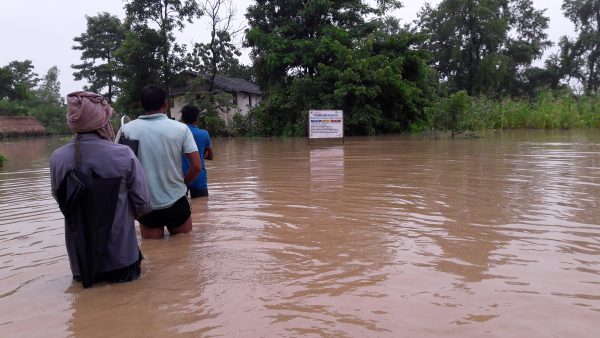Earlier this month I met with Dr. Musonda Mumba in London to talk about her work at UNEP where she leads on ecosystem based adaptation. We first came into contact with Musonda after she shared a platform with Dhananjay Regmi on Al Jazeera’s Climate Change special in June. We have since been in touch via Twitter where her following is growing.
We met in a café in Spitalfields market in the heart of London. Musonda was in the UK for a conference in Cambridge and took the opportunity to stay on for a week with her young children, visiting family and friends. She did her PhD in London and looked pleased to be back, despite the monsoon type weather we had that day. Home for her now is Nairobi, Kenya, where she works out of the UN’s Environmental Agency headquarters (the only UN agency headquartered in the south).
Musonda has worked for UNEP for almost 9 years. UNEP has undergone a soft rebranding to become UN Environment. As Musonda explained, the move is to ensure that the purpose of the programme is not lost in the jargon of an acronym. It is a change brought in by Erik Solheim, UN Environment’s Executive Director, and something Musonda is clearly in favour of.
Musonda is warm and has a witty sense of humour. Her jokes are subtle and knowing, perhaps a reflection of years spent working at a global level where international, national and local politics collide and all have a capacity to surprise, frustrate, shock or delight. Our discussion travelled from the excellent progress being made in tackling litter in east Africa through to the Anthropocene and Brexit, but we focussed in on our main shared area of interest: climate change adaptation, specifically ecosystem based adaptation.
Musonda’s expertise is in wetland hydrology, the subject of her PhD and her previous work at WWF UK. Her focus there was on conservation, protecting habitats and communities in the zones around wetland areas. Since joining UN Environment, her work has taken her around the world to countries like Peru, Nepal and, closer to home, Uganda and Tanzania. She is involved in the design and implementation of climate change adaptation projects all over the world, with a specific emphasis on fresh water ecosystems.
I asked her to explain ecosystem based adaptation (EbA) and how it relates to other approaches.
Ecosystem adaptation is part of wider strategy of adaptation, you need to have a cocktail of solutions of what’s going to work in an environment. By definition, ecosystem based adaptation is reducing the impacts of climate change while also making sure that biodiversity and ecosystem services that we are all dependent on remain healthy.
She talked me through an example from Dar es Salaam on the coast of Tanzania which, thanks to Climate Change, is increasingly prone to storm surges:
We sat down with the Tanzanian government and asked them what they would like to see us do in terms of providing mitigating factors for the communities that are along the coast, the eastern seaboard of Tanzania. We went through a cost-benefit analysis with them and the Tanzanian government said ‘it’s plain and simple, this segment of the coastline will have a sea wall, because we have a port and we don’t want our infrastructure to be damaged. And this section of the coast we are going to rehabilitate to restore some the mangrove forest that have disappeared.’
So, in Tanzania, a cocktail of solutions was settled upon, the port was protected by a human made sea wall (often referred to as grey infrastructure), while the mangrove forest (green infrastructure) was restored to help fish return. This re-established the fishing grounds that had been lost and helped revive the local economy. Musonda used this example to stress something important about the ecosystem based adaptation approaches she advocates. There is a principle of emphasising livelihoods in designing solutions. It is a pragmatic view that resonates well in political circles. It is not possible to do everything in isolation of people. The risk to natural ecosystems is climatic, but it is related to other risks and challenges faced by any particular environment or location. The cocktail of solutions must be a response to the cocktail of problems. Musonda cited a similar example from a project in Fiji, where a mix of adaptation solutions were implemented in a coastal location and there are several other examples too.
It is a story of compromise, systems thinking and the ability to look holistically at the situation. It factors in the needs of society and ecology. As a stakeholder, and often co-funder, of adaptation work UN Environment seek to champion and promote the value of ecosystems and the services they can provide. Ecosystem services are often seemingly invisible (certainly compared to a very visible sea wall) or at least overlooked, so part of Musonda’s job is to highlight their importance. She makes them feel relevant in the thinking of politicians and planners. This is why, I think, she uses terms like ‘green infrastructure’ to communicate the role ecosystems play in people’s lives. It is a linguistic technique that helps her grab the attention of her audience by using language that is familiar to them. In this way she is better able to make a case for conservation of any particular ecosystem. It takes the argument beyond a simple call to protect nature for the sake of flora and fauna alone. By highlighting the socio-economic benefits of well-functioning ecosystems, Musonda and UN Environment can convince pragmatic policy makers to adopt ecosystem based adaptation approaches. Positive outcomes for livelihoods is an important influencing lever in political decision making. Musonda seemed confident that the message is getting through:
[Ecosystem based adaptation] is happening now in the Netherlands, in Switzerland. There are a lot of countries that are now reclaiming, or giving back to nature because there is a realization now that bricks and mortar don’t do justice to a system and you don’t get back the biodiversity that you want.
But, we have not achieved blanket recognition of this worldwide yet. Indeed, the value of ecosystem based adaptation has been overlooked for numerous political and economic reason’s right here in the UK. When floods hit in Yorkshire in 2015, one town remained relatively unscathed. Thanks to the intelligent management of upland ecosystems the town of Pickering was spared while others suffered a deluge. Planners in Pickering worked with nature while other towns and cities were flooded. Right across Yorkshire, degraded upland ecosystems were not able to provide the water restricting services that had saved Pickering.
There is a global need, just like in Yorkshire, to reconnect people with the power of natural processes and ecosystem services to highlight their value and potential in climate change adaptation. This is a core task for Musonda and her colleagues at UN Environment.
Communities do understand, maybe it is a matter of articulating a lot better, even on paper and also as part of the whole educational process. Because sometimes somebody would say to me, ‘well we don’t really need this river.’ Yes we do. The river is doing a, b, c and d, these services from nature are so critical. So we had to then engage with communities to articulate on paper a lot better.
It is an effort to give people the confidence to believe in what they intuitively know, but were steered away from during an era where heavy technology was presented over and over as a salvation. This educational drive is necessary at community level, but also, more crucially, at policy level. I asked her how she felt about adaptation policy in Nepal and where we currently are with it.
Nepal is very interesting, it is one of the Climate Convention member countries that designed the NAPAs (National Adaptation Programme of Action) in a very interesting way. They came back and said we want to take the programme a notch lower or higher, we want to have LAPAs (Local Adaptation Programme of Action). They have a very interesting local jurisdiction process for governance and a lot of countries learned from that, because they had to go to up to the community level and design and identify the most vulnerable and urgent action required, as per the NAPA process, but really at the microcosm of the village. Things start going missing as you go up the ladder of the governance structure. By the time you get to the provincial level the understanding of what is going on at the community level is almost lost.
But, Nepal does not seem to have got there quite yet. Musonda told me that a lot of the policy in Nepal, like many developing countries, is fantastic on paper, but they are yet to be fully implemented. The 2015 earthquakes naturally and understandably changed the priorities for all decision makers from village level to national Government level. Musonda was working in Nepal at the time of the earthquakes and told me what the changing priorities meant for their EbA work:
In a number of spaces it has been an opportunity to rethink some of the implementation processes in response to the disaster and the need for rebuilding. What was interesting to me in the foothills in Nepal, where we were working, were the demographic shifts. A lot of the areas in and around the middle areas of the Himalayas are getting depopulated of men. So they now have predominately female and old people households. The challenge is that Nepal’s policies are pretty patriarchal and you are doing this in an environment that has become predominantly female. Therefore, at a local level, when you are making a decision in terms of how you are going to manage, or what you are going to grow in this particular area, you really can’t make a decision because you have to get permission from someone in Kathmandu who owns the land and you are 300 kilometres away.
In response, the conversations UN Environment and its partners are having with the Nepali government centre on designing policy instruments that allow women to make these decisions at a local level. Not having to wait for a long time as discussions flow through patriarchal systems of husbands, brothers, uncles, fathers and grandfathers who are often many miles away would make a huge difference.
How do you create that balance, bearing in mind the gender balance and the demographic shifts that have happened over quite a long time, to empower the community? Particularly the women, to make sure that they are aware that they can do all of these activities and build resilience in their own right under the new circumstances, which are almost the new normal.
Finding an answer to this question is a task for all NGOs as well as Government bodies working in Nepal today. There are some examples of good practice to draw on the COPILA project that The Glacier Trust has supported along with Helvetas and others in Nepal is an example, as is our work in Solukhumbo. But the need to spread awareness of these issues and factor them into project design and implementation remains. This is not only an issue facing Nepal, demographic shifts are happening worldwide and altering gender balance and age profiles in villages everywhere.
As our conversation broadened out Musonda told me about her current work and a trend she has noticed in how adaptation programmes are being designed:
Depending on the Government we are working with, the decision around the [Climate Change] adaptation process is dependent on community needs and also who they are trying to access resources from. What has happened more now in the development / climatic world is that the World Bank, for the first time has an ecosystem based approach mechanism to their infrastructure. Also now, because of its nature as a bank it has put in specific safeguards, looking at the implications of a road, bridge, railway system, etc. So, what is happening a lot more now is that there is a lot more screening: ‘fine you need a road, what material are you using? What are the implications?’ Because when a flood hits, the porosity of the ground is important. If it is less porous all hell breaks loose.
Systems thinking is taking a hold. Investment in adaptation projects is being done after some deep critical thinking about the broad consequences of decisions on things like the type of road surface. As decision makers at agencies like the World Bank are becoming more versed in ecosystem services and the value of ecosystem based adaptation, the programmes and projects they funnel funding towards are those that are being designed with that sort of thinking in mind. Hearing this from Musonda gives me hope that nature might become a more potent ingredient in the cocktail of adaptation solutions.
























